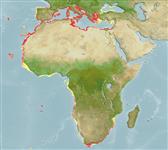>
Eupercaria/misc (Various families in series Eupercaria) >
Sparidae (Porgies)
Etymology: Sarpa: Spanish, sarpo, sapo = toad; a toad-fish (1753) (Ref. 45335).
More on author: Linnaeus.
Environment: milieu / climate zone / depth range / distribution range
Ecología
marino; salobre bentopelágico; oceanodromo (Ref. 51243); rango de profundidad 5 - 70 m (Ref. 3688). Subtropical; 45°N - 40°S, 26°W - 36°E
Eastern Atlantic: Bay of Biscay and Strait of Gibraltar to Sierra Leone, including Madeira, the Canary Islands, and Cape Verde; Congo to South Africa. Also present in the Mediterranean.
Length at first maturity / Tamaño / Peso / Age
Maturity: Lm 16.5 range ? - ? cm
Max length : 51.0 cm SL macho / no sexado; (Ref. 3397); common length : 30.0 cm SL macho / no sexado; (Ref. 4781)
Espinas dorsales (total): 11 - 12; Radios blandos dorsales (total): 14-17; Espinas anales 3; Radios blandos anales: 13 - 15. Black spot at the pectoral fin base. Body relatively slender with 10 golden longitudinal stripes (Ref. 35388).
Found over rocky substrates and sandy area with algal growth. Gregarious, sometimes forming sizeable schools. Young mainly carnivorous on crustaceans, adults almost exclusively herbivorous (Ref. 4781), feed on seaweeds (Ref. 36731). Protandric hermaphrodite (Ref. 4781). Tasty when fresh, but easily softens and is not much esteemed (Ref. 3198).
Life cycle and mating behavior
Madurez | Reproducción | Puesta | Huevos | Fecundidad | Larva
A monandric species (Ref. 55367). Sex change occurs at 25.0 cm TL and 3.75 years of age (Ref. 55367). Conflicting descriptions of the reproductive style of this species have been reported, including possible gonochorism (Ref. 103751). Also Ref. 28504.
Bauchot, M.-L. and J.-C. Hureau, 1990. Sparidae. p. 790-812. In J.C. Quero, J.C. Hureau, C. Karrer, A. Post and L. Saldanha (eds.) Check-list of the fishes of the eastern tropical Atlantic (CLOFETA). JNICT, Lisbon; SEI, Paris; and UNESCO, Paris. Vol. 2. (Ref. 3688)
IUCN Red List Status (Ref. 130435)
Threat to humans
Harmless
Human uses
Warning: mysqli::__construct(): (08004/1040): Too many connections in /var/www/html/includes/func_getlabel.php on line 46
Can't connect to MySQL database (fbapp). Errorcode: Too many connections
